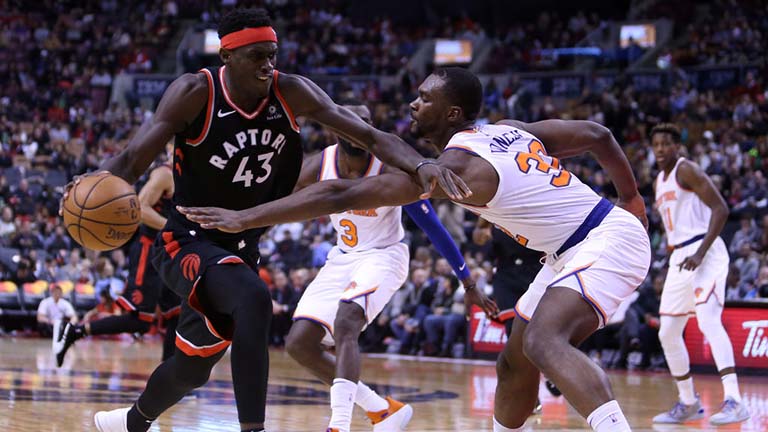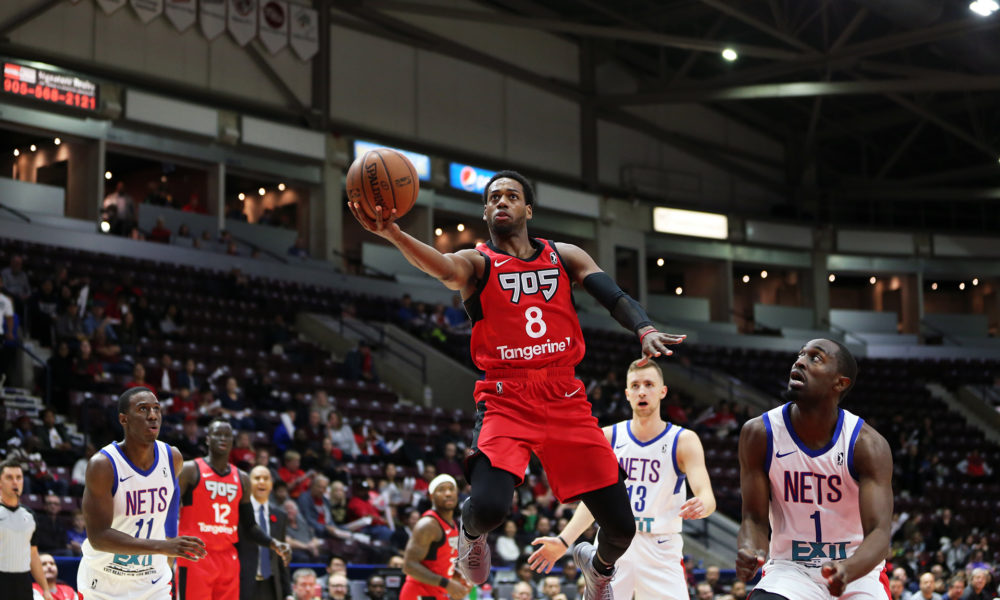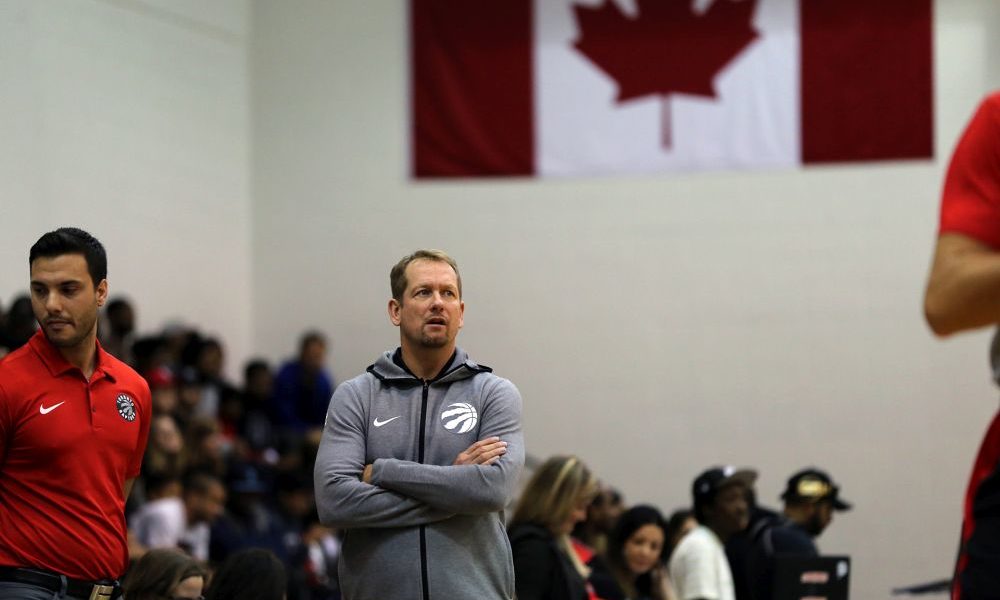Recap
- The Raptors overcame a sloppy start to methodically pull away from the Knicks in a comfortable win, where no Raptor played more than 28 minutes.
- The Raptors struggled in the first half with turnovers (6 in the first quarter, 10 in the first half) and very poor defensive rebounding (9 in the first quarter, 13 in the first half).
- Defensively, the Raptors were once again very solid. They defended the ball screen reasonably well, limited the Knicks to only 22 3s (making 9 of them), and defended the nail very well.
- The Raptors had good success offensively against the Knicks who wide hedged the ball screen. I’ll go into more detail on that below.
- Pascal Siakam was great offensively, scoring in a variety of different ways but most notably shooting 3 of 4 from the 3 point line.
- The Raptors gave more offensive touches tonight to OG Anunoby than they usually do.
Defensive Rebounding
- The Raptors have struggled on the defensive boards at times this year, and the Knicks exposed them in the first half tonight.
- They were poorly rebounding, rarely grounding opposing players and almost never fundamentally boxing out their match-up. Let’s look at a few examples:
The Raptors have 5 players in the paint here, but can’t contain Kanter. Green has an opportunity to ground him, and could work to get in front, but doesn’t.
In the clip, Lowry does a decent job of boxing out, but the other Raptors leak out. Both Siakam and Ibaka could easily end this possession if they went towards the rim on the shot, but they both are moving towards half.
This is simply CJ Miles losing sight of his man and expecting his teammates to come up with the rebound. He gets out of stance, loses sight of Knox, doesn’t box him out, and Knox walks into an offensive rebound.
On the opposite side, watch this clip. JV simply grounds Kanter, and the Raptors’ guards can clean up the rebounds:
- Defensive rebounding is not rocket science by any means. There are fundamentals that need to be applied to rebounding (boxing out, tracking the ball, being in stance), but those fundamentals will always come second to effort and a willingness to go get the ball.
Defending the Nail
- I have talked about this a lot, but again, the Raptors were great at the nail in this game. I noticed one clip in particular that I wanted to share:
This is a progression to their bluff at the nail. Notice how after Siakam does his job and forces the kick out at the nail, OG bluffs the shooter to give Siakam half a second longer to recover and contest the shot. Earlier in the year, the Raptors had done a very good job of the initial bluff, but had not been bluffing on the kick-out. This is a good example of how the Raptors are continuing to grow in their understanding of their defense.
Ball Screen Offense
- The Raptors continued to have success in the ball screen against the Knicks. This was in large part due to the way the Knicks handled the ball screen defensively.
- The Knicks wide-hedged the ball screen, which in terms of how the big defends it, is somewhere in between hedging the ball screen and waiting in the paint – the big meets the ball handler at the level of the screen and begins his retreat from there. The advantage to handling the ball screen this way is that you prevent the mid-range pull up effectively. The downside, however, is that it opens up the basket to the roller and therefore forces the other 3 defenders to have to cover 4 offensive players, which can lead to kick outs. Let’s look at some examples:
Notice Kanter wide hedge the ball screen in this clip. He is much higher on the court than how the Raptors handle it, and it doesn’t allow Lowry to shoot the 3 or pull up. However, it forces the other 3 Knicks to compensate for Ibaka rolling to the rim. Watch how Siakam’s defender, the low defender on the 2 side (side of the floor that has 2 offensive players), is drawn to the basket by Ibaka’s roll and therefore leaves Siakam wide open in the corner.
Same action here, but the defender who compensates for the roll is on the 1 side (side of the floor with 1 offensive player). As he is drawn in to protect against the roll, he leaves OG wide open for a 3. Usually, the defender who is the lowest on the 2 side would protect against the roll, but with the 3 second defensive rule not allowing that player to sit at the basket, it leads to a lot of space for that defender to cover.
Again, the wide hedge forces a defender to sink and cover the roll. In this case, it’s Knox on the 1 side who is in a very difficult situation as he has to cover the roll, but is worried about giving up on open 3. He drops to Ibaka, but then Lowry moves Knox with his eyes by looking at OG, which Knox bites on. This leaves Ibaka wide open at the rim.
- In addition to wide hedging mid-ball screens, the Knicks also chose to wide hedge on wing ball screens. The Raptors countered by overloading the offside of the floor, which really caused problems for the Knicks.
Usually NBA teams will ICE wing ball screens (deny access to the middle of the floor) because, again, the offside low defender cannot wait in the key. Notice here how Hezonja is just too far away from JV on the roll to effectively be able to cover the roll. By overloading the offside, the Raptors are forcing the Knicks to give up the roll or send Hezonja to the strong side of the key before the ball screen happens, which would leave a 3 on 2 on the offside.
Same situation again. The Knicks wide hedge and again give up the roll. By the time the offside help can get to JV, he has already caught the ball and is going downhill towards the rim.
Shorting the Ball Screen
- A nice adjustment the Raptors have made to their ball screen spacing is spacing the floor with “short” spacing. The Raptors have shown this occasionally in the past, but they are beginning to use it more often. The reason they have gone to this is because of Siakam’s poor shooting from the 3 (although he shot much better this game). The purpose of this spacing is to put all 3 offensive players not involved in the ball screen within their shooting range, forcing the defense to respect all of them.
Notice here how instead of Siakam standing on the 3, he is spaced to the ball side dunkers spot. When his man leaves to help on the roll, Siakam is now in a range where he can consistently score, forcing the Knicks to have to respect him. If this was a better pass, it’s likely a dunk, but regardless it forced Kawhi’s defender to rotate down to Siakam which leads to an open Kawhi 3.
Exact same spacing here. Ibaka hesitates as if he is expecting help, but Siakam shorts this ball screen. This limits Leonard’s defenders ability to help on Ibaka because he knows that he doesn’t have another defender behind him who could bluff or help on Leonard.
Notes
- Teams that have tried to hedge the ball screen against the Raptors (both high hedging and wide hedging) have had very limited success. Earlier this year, the Timberwolves attempted to high hedge the ball screen and the Raptors picked them apart.
- If Pascal Siakam can consistently shoot the 3 like he did tonight, he will become very scary for opposing teams. His growth since last year has been incredible, and consistently knocking down open 3 is the next step for him.
- On the first play of the game, the Raptors tried to catch the Knicks off guard with a wrinkle to their step up action that they run quite often:
Typically, Green hands the ball back off to Lowry who uses the step up screen from Ibaka. In this situation, Green faked the hand-off and Lowry came off a flair screen from Ibaka. As a play the Raptors run quite often, the Knicks likely scouted this action. Expecting that they were prepared for this, Nick Nurse threw in a wrinkle on the very first play to try and counter their preparation.



